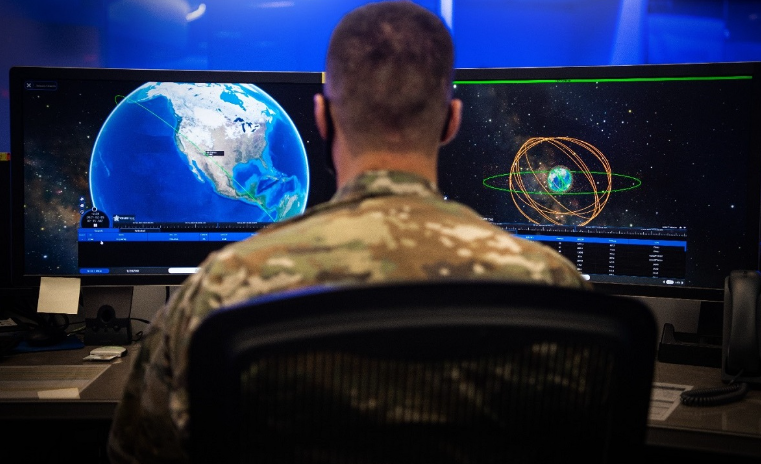GAO: US Space Force Faces Hurdles Integrating Unified Data Library into Space Situational Awareness Operations

Crews of the National Space Defense Center at Schriever Space Force Base, Colo. provide space situational awareness (U.S. Space Force Photo)
The U.S. Space Force faces challenges in integrating the Unified Data Library (UDL) into space situational awareness (SSA) operations, according to a new Government Accountability Office (GAO) report.
“The Secretary of the Air Force should ensure that the Space Force creates a plan for programs to determine how to use the UDL to access and manage all data for Space Force SSA systems,” GAO said in the study, Space Situational Awareness: DoD Should Evaluate How It Can Use Commercial Data, GAO-23-105565.
UDL is to serve as a centralized, cloud-based data repository for space domain awareness/space defense and is to contain space situational awareness from DoD, academic, commercial, and foreign sources.
“The Space Force has deployed an initial operational version of the UDL and plans to further develop it; however, staff who monitor objects in space are not using it in daily SSA operations because it is not integrated into their operational systems,” the GAO said in its new report. “A plan on how to use the UDL with SSA operational systems would facilitate the Space Force’s ability to benefit from the amount of data in the UDL.”
In 2021, Colorado-based Bluestaq LLC received a $280 million Space Force contract to develop the UDL. One organization that has been involved in UDL testing and that will use UDL is U.S. Space Command’s Joint Task Force-Space Defense at Schriever Space Force Base, Colo.
While space object tracking has been the province of DoD, a number of commercial companies are able to perform such tracking, and DoD should boost its use of such commercial tracking, GAO said in the report.
GAO referenced a report in March last year by the Defense Intelligence Agency (DIA) that said that “the primary risk to spacecraft in orbit is from uncataloged lethal nontrackable debris (LNT), which are objects between 5 millimeters and 10 centimeters in size.”
“An estimated 600,000 to 900,000 pieces of uncataloged LNT are in LEO [Low-Earth Orbit],” per the DIA study, Challenges to Security in Space: Space Reliance in an Era of Competition and Expansion. “Prior to 2007, most debris came from explosions of upper stages of SLVs [space launch vehicles]. Today, nearly one-half of all cataloged debris are fragments from three major events: China’s destruction of its own defunct weather satellite in 2007, the accidental collision between a U.S. communications satellite and a dead Russian satellite in 2009, and the 2021 Russian Nudol ASAT test.”
The UDL is to serve as a data source for L3Harris Technologies’ Advanced Tracking and Launch Analysis System (ATLAS), which is to replace the Space Defense Operations Center (SPADOC), a space situational awareness computer system established in 1979 at the North American Aerospace Defense Command’s Cheyenne Mountain Complex in Colorado. Omitron and Parsons Corp. are subcontractors to L3Harris on ATLAS.
Space Force expects ATLAS’ machine-to-machine interfaces to lead to a dramatic increase in the speed of processing and integrating space domain awareness data from a variety of commercial, civil, and military space sensors.
Begun in 2009, the Joint Space Operations Center Mission System (JMS) was a previous Air Force effort to replace SPADOC, but the Air Force canceled JMS in 2019 after it faced technical and cost challenges. JMS was to process and integrate inputs from a variety of sensors, Omitron was a subcontractor on JMS’ Increment 2–the effort to make JMS operational.
In October 2018, the Department of the Air Force awarded an initial $53 million contract to L3Harris for ATLAS.
In fiscal 2024, the Space Force requests $187 million for the UDL, nearly $160 more than the $29 million appropriated last year.
“The Space Force has deployed an initial operational version of the UDL and plans to further develop it through 2024,” GAO said in the new report. “Although the UDL is operational, the 18th and 19th Space Defense Squadron operators are not using it in daily SSA operations. Furthermore, the Space Force lacks a plan to address challenges it faces using the UDL with SSA operational mission systems.”
“The Space Force began development of the UDL as a research and development effort in 2018 for $150,000,” per GAO. “In April 2022, data from the Space Fence radar were directly uploaded and made available to the classified UDL, establishing the UDL’s first direct DoD sensor connection. This demonstrates the UDL’s ability to connect to a sensor in the DoD Space Surveillance Network, which includes all of DoD’s SSA sensors. Since April, the UDL has connected to an additional sensor at the classified level and several other sensors at the unclassified level.”
Lockheed Martin built the $1.6 billion S-band Space Fence radar on Kwajalein Atoll in the Marshall Islands. Space Fence achieved initial operational capability on March 27, 2020.
“Although the UDL is used as a repository for commercial and DoD SSA data, DOD’s SSA C2 [command and control] systems—SPADOC and the Correlation, Analysis, and the Verification of Ephemerides Network (CAVENet)—are largely not taking data from the UDL,” GAO said in the new report. “The 18th and 19th Space Defense Squadrons rely on these SSA C2 systems to perform their mission functions, such as assessing potential collisions and maintaining custody of space objects. These systems use DOD’s SSA data in the catalog to carry out these functions, but not commercial SSA data from the UDL.”
This story was first published by Via Satellite sister publication Defense Daily.